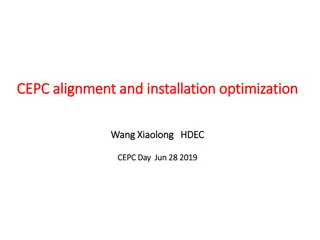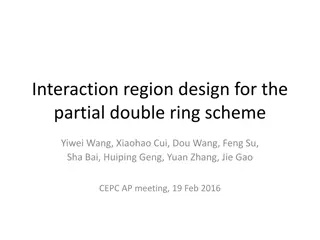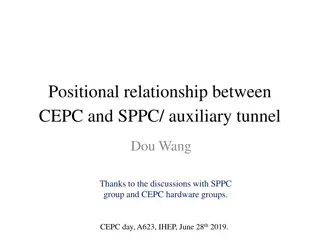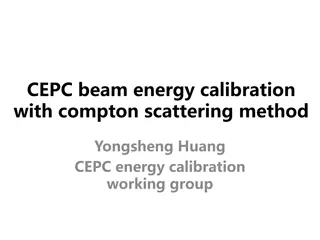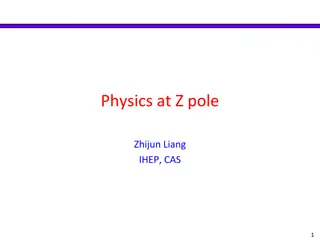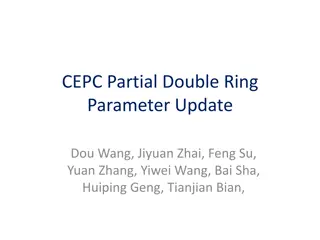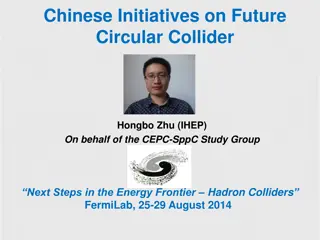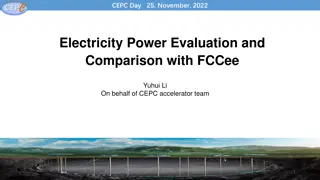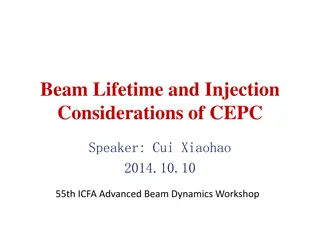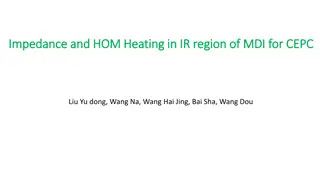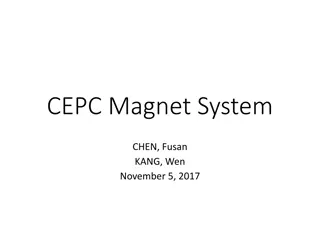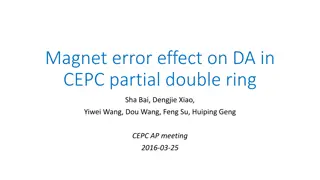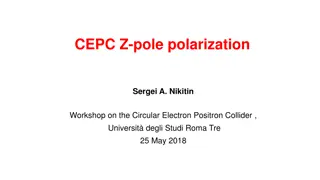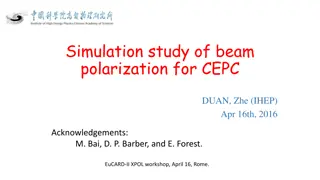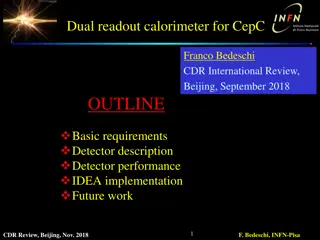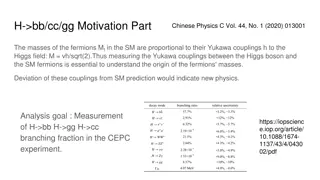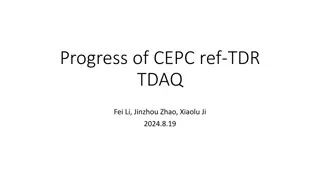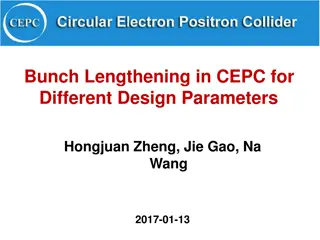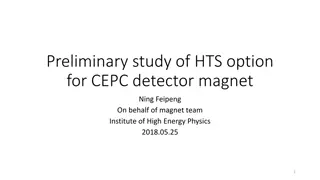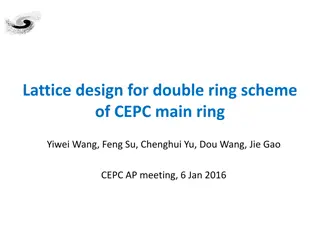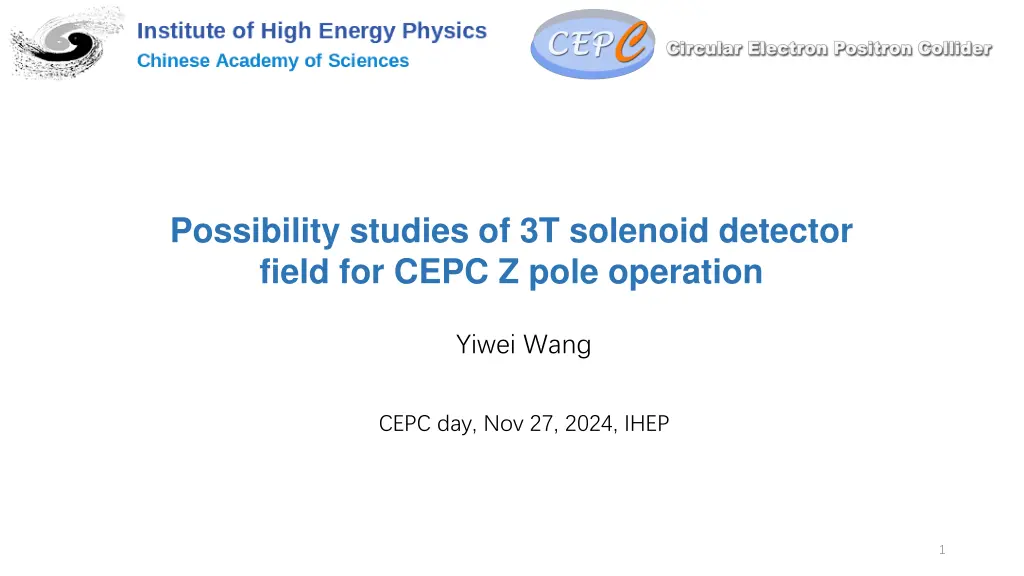
Studies on Solenoid Field Compensation for CEPC Z-Pole Operation
Through possibility studies of a 3T solenoid detector field for CEPC Z-pole operation, detailed investigations on solenoid field compensation in CEPC TDR are presented. The study includes local and non-local compensation schemes, optimization for emittance minimum, and technical design considerations. Various scenarios and their effects on beam dynamics and luminosity are discussed.
Download Presentation

Please find below an Image/Link to download the presentation.
The content on the website is provided AS IS for your information and personal use only. It may not be sold, licensed, or shared on other websites without obtaining consent from the author. If you encounter any issues during the download, it is possible that the publisher has removed the file from their server.
You are allowed to download the files provided on this website for personal or commercial use, subject to the condition that they are used lawfully. All files are the property of their respective owners.
The content on the website is provided AS IS for your information and personal use only. It may not be sold, licensed, or shared on other websites without obtaining consent from the author.
E N D
Presentation Transcript
Possibility studies of 3T solenoid detector field for CEPC Z pole operation Yiwei Wang CEPC day, Nov 27, 2024, IHEP 1
Outline Solenoid field compensation in CEPC TDR Possibility studies of 3T solenoid detector field for CEPC Z pole operation Local, non-local scheme Work to be done and summary
Solenoid field compensation in CEPC TDR Updated detector Updated detector solenoid field @ W/Higgs/ttbar W/Higgs/ttbar ( (Scaled to 2T at IP @ Z Scaled to 2T at IP @ Z) ) solenoid field @ Data from Feipeng Ning The detector solenoid are compensated locally with anti- solenoids From IP to the entrance of Q1A (0 to 1.9m): Bzdz cancled between the IP and the entrance of final quadrupole with strong anti-solenoid field in 1.1m to 1.9m. Field configuration optimized to get emittance minimum and iterate with anti-solenoid technical constraints 3.5 3 2.5 tentative, to be optimized with the evolution of the detector design 2 Bz(T) 1.5 1 0.5 Z(m) 0 From the entrance of Q1A to Q3(1.9m to 10.55m) 0.00 5.00 10.00 15.00 20.00 25.00 30.00 35.00 Z(m) Bz keep fully cancellation along this region Compensated solenoid field from IP to the entrance of Q1A (same with TDR for combined field) Emittance contribution from the from IP to the entrance of Q1A From the Q3 to the last bend (farer than 10.55m) Bzdz from detector only < 0.5 T*m. Version Ttbar (3T) Higgs (3T) W (3T) Z (2T) Along beam line (not z), fully cancelation in Q3 and pre-cancelation in some extension region (with length of 1m) for the long tail of the detector solenoid field 4.7 4.7 1.3 1.3 1.7 1.7 1.4 1.4 ???(pm) (pm) op. design op. design ??(pm) (pm) 0.03 0.03 0.26 0.26 0.85 0.85 0.67 0.67 Z scaled to 2T Z scaled to 2T tech. design v6 ??(pm) 0.04 0.41 1.35 1.07 tech. design tech. design V7 V7 ??(pm) 0.04 0.04 0.36 0.36 1.20 1.20 0.95 0.95 (pm) 3
Possibility studies of 3T solenoid detector field for CEPC Z pole operation Para table by D. Wang, Nov 2024 If keep local compensation scheme Bz0 2 T=>3 T vertical emittance 0.95pm => 7.2pm, possible to reduced to 5.1 pm (excluded other region) by optimize the technical design Compensated solenoid field from IP to the entrance of Q1A (same with TDR for combined field) Emittance contribution from the from IP to the entrance of Q1A Version Ttbar (3T) Higgs (3T) W (3T) Z (2T) 4.7 4.7 1.3 1.3 1.7 1.7 1.4 1.4 ???(pm) (pm) op. design op. design ??(pm) (pm) 0.03 0.03 0.26 0.26 0.85 0.85 0.67 0.67 Z scaled to 2T Z scaled to 2T tech. design v6 ??(pm) 0.04 0.41 1.35 1.07 tech. design tech. design V7 V7 ??(pm) 0.04 0.04 0.36 0.36 1.20 1.20 0.95 0.95 (pm) Lumi may be a bit lower due to coupling in other regions Highl lumi Z: 115*10^34/cm^2/s
Possibility studies of 3T solenoid detector field for CEPC Z pole operation If non-local compensation scheme Bz0 2 T=>3 T asumming same length of anti-solenoid in front of the final quadrupoles, dBz 5.7 T => 3 T, vertical emittance 0.95pm => 0.04pm effect on Beam dynamics : Peak luminosity will not be limited by the vertical emittance, but the residual orbit and dispersion will disturb the beam dynamics: beam lifetime, polarization effect on MDI: Ani-solenoid Bzmax 5.7 T => 3 T, synchrotron radiation power will be reduced with 1/Bzmax^2
FCCee local vs. non-local compensation A. Ciarma, H. Burkhardt, P. Raimondi et al A. Ciarma et al, IPAC24 Emittance reduced 0.195 pm to 0.002 pm local SR power reduced from 80 kW to 12 kW/IP Non-local
FCCee local vs. non-local compensation K. Oide K. Oide, 11 Nov 2024 Emittance reduced 0.43 pm to 0.24 pm The vertical emittance of type F still looks larger than Burkhardt/Ciarma s, but it is already enough small. The recent required lattice vertical emittance is 1.0 pm local The type F with seems usable, except for the polarization. A polarization tuning such as vertical bump in the arc is necessary Non-local
FCCee local vs. non-local compensation (cont.) K. Oide The type F with seems usable, except for the polarization. A polarization tuning such as vertical bump in the arc is necessary
Beam-Beam with solenoid (local scheme) Beam lost
Summary Possibility studies of 3T solenoid detector field for CEPC Z pole operation With local compensation scheme: 115 => 26E34/cm^2/s With non-local compensation scheme effect on Beam dynamics : Peak luminosity will not be limited by the vertical emittance, but the residual orbit and dispersion will disturb the beam dynamics: beam lifetime, polarization (to be checked) effect on MDI: Ani-solenoid Bzmax 5.7 T => 3 T, synchrotron radiation power will be reduced with 1/Bzmax^2
CEPC Design Parameters W Higgs Z ? ? - ?y and emittance chosen for luminosity adequate bunch population Ne for the luminosity and the achievable energy acceptance for lattice design Number of bunches Nb is adjusted to keep the beam current Updated bunch spacing for the requirement from detector (D. Wang, Aug 2024, CEPC day) Number of IPs Circumference (km) SR power per beam (MW) Half crossing angle at IP (mrad) Bending radius (km) Energy (GeV) Energy loss per turn (GeV) Damping time x/ y/ z (ms) Piwinski angle Bunch number Bunch Spacing (ns) Bunch population (1011) Beam current (mA) Phase advance of arc FODO ( ) Momentum compaction (10-5) Beta functions at IP x*/ y*(m/mm) Emittance x/ y(nm/pm) Betatron tune x/ y Beam size at IP x / y (um/nm) Bunch length (natural/total) (mm) Energy spread (natural/total) (%) Energy acceptance (DA/RF) (%) Beam-beam parameters x/ y RF voltage (GV) RF frequency (MHz) Longitudinal tune s Beam lifetime (min) Hourglass Factor Luminosity per IP (1034cm 2s 1) 2 100.0 30 16.5 10.7 - 45.5 0.037 120 1.8 80 180 9.1 0.357 816/816/408 24.23 11934 23.1 1.4 803.5 60 1.43 0.13/0.9 0.27/1.4 317/317 6/35 2.5/8.7 0.04/0.13 1.0/1.7 0.004/0.127 0.12 44.6/44.6/22.3 4.88 268 576.9 1.3 16.7 90 0.71 0.3/1 0.64/1.3 445/445 14/36 2.3/4.1 0.10/0.17 1.6/2.2 0.015/0.11 2.2 13.2/13.2/6.6 1.23 35 4523.1 2.0 3.3 90 0.71 1.04/2.7 1.4/4.7 445/445 39/113 2.2/2.9 0.15/0.20 2.0/2.6 0.071/0.1 10 150/150/75 5.98 1297 253.8 1.35 84.1 60 1.43 0.21/1 0.87/1.7 317/317 13/42 2.5/4.9 0.07/0.14 1.05/2.5 0.012/0.113 0.7 - - Ref: CEPC TDR; Radiation Detection Technology and Methods (2024) 8:1 1105, https://doi.org/10.1007/s41605-024- 00463-y; 650 0.049 18 0.9 5.0 0.035 77 0.97 115 0.078 18 0.89 0.5 0.062 22 0.9 16 12 CEPC workshop 2024


